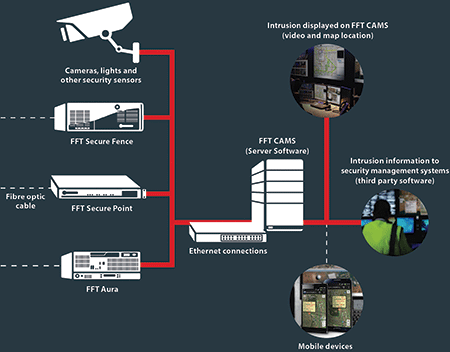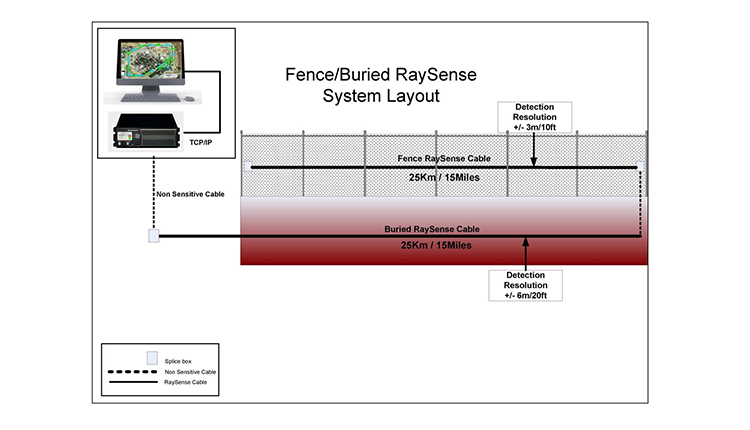Improve Your Security With Advanced Fiber Optic Protection Systems
In an era where security is critical, innovative fiber optic protection systems offer a compelling option for boosting security throughout numerous environments. What implications do these developments hold for future safety actions?
Advantages of Fiber Optic Safety
Taking advantage of the benefits of fiber optic innovation significantly boosts safety and security systems across various applications. One of the primary benefits is the raised data transfer capacity, permitting the transmission of huge amounts of information at broadband. This is specifically critical for real-time video monitoring, where high-resolution feeds can be sent without latency, ensuring immediate response capabilities.
In addition, optical fiber exhibit superior resistance to electro-magnetic interference, which is crucial in settings with prospective signal disturbances. This integrity ensures regular performance in essential protection operations. Fiber optic wires are less vulnerable to tapping and unauthorized gain access to contrasted to typical copper electrical wiring, thus improving information stability and discretion.
One more remarkable advantage is the durability of fiber optic systems; they are a lot more resistant to ecological aspects such as dampness, temperature fluctuations, and corrosive compounds. This strength translates to decrease upkeep prices and longer life expectancies for safety installments.
Lastly, the lightweight nature of fiber optic cords assists in less complicated installation and routing, specifically in complex infrastructures (fiber optic security system). Inevitably, the integration of fiber optic technology into security systems not just bolsters protection steps but also optimizes functional performance
Key Features to Take Into Consideration
When reviewing fiber optic security systems, several key functions have to be considered to ensure optimal efficiency and performance. Examine the system's discovery range and sensitivity; an extensive variety permits for checking big areas, while high sensitivity makes sure that even minor disruptions are found immediately.
Next, take into consideration the assimilation capacities of the system. A fiber optic protection system must flawlessly user interface with existing safety and security measures such as cams and alarms, developing a natural safety and security network.
Durability and ecological resistance are likewise critical attributes. Ensure that the system is made to stand up to harsh weather and possible physical risks, as this will certainly prolong its functional lifespan.

Lastly, consider the scalability of the system. A robust fiber optic safety and security system should be easily expandable to fit future demands without significant overhauls. By carefully taking into consideration these functions, you can select a fiber optic security remedy that improves safety and security and safety and security in your environment.
Installment Process Overview
To effectively carry out a fiber optic safety and security system, an organized web setup process is essential. This procedure starts with a thorough site assessment to identify the specific security requirements and to recognize optimal places for fiber optic cables and protection devices. Following this evaluation, the installation team will certainly develop an in-depth plan, consisting of cable pathways, required equipment, and compliance with regional laws.
Next, the installment entails laying the fiber optic cords, ensuring they are shielded from ecological factors and physical damage. Appropriate handling strategies are vital, as fiber optic cables are delicate and can be conveniently harmed. After the cabling is installed, ports and discontinuations are meticulously completed to make certain signal stability.
The succeeding phase contains setting up safety tools such as cameras, browse around these guys activity detectors, and alarm, all integrated with the fiber optic network. Strenuous screening is carried out to confirm that all components are operating appropriately and to make sure optimal performance.

Comparing Fiber Optic to Standard Solutions
The development of security modern technology has actually brought about considerable advancements in the contrast in between fiber optic systems and conventional copper-based systems. Fiber optic systems make use of light to transmit data, providing superior transmission capacity and rate contrasted to their copper counterparts. This results in enhanced information transmission capacities, making optical fiber optimal for high-resolution video monitoring and real-time monitoring.
In addition, fiber optic cords are immune to electromagnetic interference, lowering the possibility of signal destruction triggered by outside factors. This particular guarantees consistent efficiency, even in tough atmospheres. In comparison, traditional copper systems are a lot more at risk to interference, resulting in potential vulnerabilities in protection applications.
Resilience is an additional advantage of fiber optic systems. They are less susceptible to harm from ecological factors such as wetness and temperature fluctuations, which can endanger copper wiring. Fiber optics are lighter and thinner, permitting for simpler setup and reduced physical footprint.
Nonetheless, conventional systems have a tendency to have reduced preliminary prices, making them appealing for budget-conscious jobs. While fiber optic systems may need a higher ahead of time investment, their long-lasting benefits-- such as lower upkeep costs and better integrity-- frequently surpass the first expense, placing them as a superior selection for modern-day protection needs.
Future Trends in Security Modern Technology
Arising trends in security technology are positioned to change the landscape of security and threat discovery - fiber optic security system. As companies significantly encounter sophisticated hazards, innovations such as expert system (AI) and device learning (ML) are coming to be indispensable to protection systems. These modern technologies improve the capability of fiber optic systems by enabling real-time data analysis, determining anomalies, and automating reactions to potential violations
Additionally, the integration of the Net of Points (IoT) is changing safety structures. IoT gadgets can offer comprehensive situational understanding and help with smooth interaction between various safety elements. This interconnectedness enables extra effective monitoring and faster case action times.
Biometric authentication is additionally getting momentum, giving a higher degree of safety through one-of-a-kind physical qualities. As this technology progresses, it is likely to be included into fiber optic systems for boosted access control.
Verdict
To conclude, progressed fiber optic safety and security systems stand for a considerable innovation in security and security innovation. Their premium data transfer, resistance to disturbance, and toughness help with trusted tracking and information integrity. As these systems integrate AI and IoT capabilities, they enhance the general safety and security framework, address guaranteeing durable protection for assets. The shift from typical systems to fiber optic services shows a growing trend towards extra efficient and effective protection measures in a progressively intricate technological landscape.
Comments on “Why a Fiber Optic Security System Is Crucial for Sensitive Facilities and Environments”